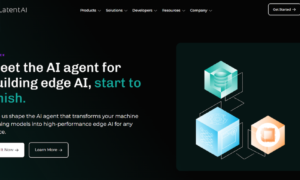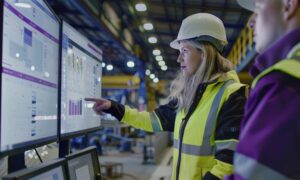Alexander Passler is the Co-Founder and CEO at Vallist.
Talent only gets you so far. There’s the analogy that a bad workman blames his tools, but that feels a little bit outdated when it comes to office tech. Sure, Bezos and co regularly cast out a net to sweep up the best in tech talent, but what is that talent if they aren’t working in the right conditions to maximize their potential? Mountain View and Menlo Park are pantheons of the tech world for a reason, and there’s a reason why multi-billion dollar tech companies invest so much into their office tech. This brings us to the transformative role of the Internet of Things (IoT) in redefining our workspaces. It’s not just about the talent we hire, but also about how IoT technology is revolutionizing the environments we create for them to thrive.
The Internet of Things
Too often we see this term commoditised; IoT goes well beyond asking your Alexa to turn on the kitchen lights. IoT devices have had a profound impact on the way offices operate, creating more sustainable and productive workspaces. I’ve worked in commercial (and office) real estate for the best part of three decades, and so I’ve seen firsthand how companies are leveraging these innovations not just for the sake of advancement, but to genuinely foster a thriving, efficient workplace.
Most of the companies that we idolise have successfully leveraged IoT devices and smart technology to gain a competitive edge in their workplace environments. Amazon, for instance, has deployed IoT-connected devices in its fulfillment centers to automate tasks like order picking and packaging, reducing physical strain on employees. They’ve also implemented IoT-based environmental controls to regulate temperature and ventilation. Most visible among their innovations are their cashierless grocery stores, which employ IoT sensors and computer vision to automate the shopping experience, disrupting the retail landscape by offering customers a faster and more convenient way to shop. This allows them to reduce their labor force, thereby driving higher margins at the unit level.
Other tech juggernauts, like SAP and Cisco, have integrated IoT technology into their offices with smart building solutions. Sensors monitor indoor air quality, temperature, and lighting, providing real-time data to employees via mobile apps for a more pleasant working atmosphere. Microsoft adopts IoT technology to enhance the workplace experience. They monitor space utilization and improve office layouts and energy efficiency, promoting sustainability while also providing workspaces that drive innovation and productivity. IBM has taken a unique approach to employee well-being by using IoT devices for safety and comfort. In their manufacturing facilities, IoT sensors and wearables monitor employees’ physical health, ensuring they do not overexert themselves.
Seeing the success of these tech giants, it becomes clear that the principles they apply can be adapted to any business seeking to enhance their workspace with IoT. Let’s explore how these innovations can be realistically implemented in your own office environment.
How to nurture growth through office tech
Energy efficiency
Energy efficiency, a critical aspect of modern workspaces, has been revolutionized by IoT-connected lighting systems. These systems are a testament to how technology can be both environmentally conscious and cost-effective, adapting to natural light and occupancy, ensuring minimal energy wastage. Imagine walking into a room that lights up to your presence and dims when you leave, optimizing energy use without a second thought from you. This is the kind of intuitive efficiency that nurtures growth by reducing operational costs and enhancing the work environment.
Comfort
Similarly, HVAC systems equipped with IoT sensors offer a fine-tuned approach to maintaining comfortable office climates. Monitoring factors like temperature and humidity, they dynamically adjust settings, ensuring a comfortable environment for employees. This is crucial, as a comfortable employee is an efficient one. But there’s more to it than comfort; these systems also reduce energy consumption, striking a balance between employee well-being and environmental responsibility.
Environmental impact
On environmental responsibility, real-time energy monitoring facilitated by IoT sensors offers a window into areas of energy inefficiency, guiding us in making informed decisions to cut down costs and environmental impact. This approach aligns with the increasing employee concern for their company’s environmental footprint. It’s about making impactful changes within our immediate work environment – starting from where we spend most of our workday.
IoT forecasting
Now, let’s talk about predictive maintenance and space utilization – two areas where IoT devices shine in enhancing employee well-being and operational efficiency. Sensors placed on office equipment collect data on usage and performance, enabling us to anticipate maintenance needs. This proactive approach prevents downtime and costly breakdowns, ensuring a seamless work environment. Additionally, tracking office space usage helps in optimizing space allocation, directly impacting overhead costs. In a world where real estate is a premium, understanding and maximizing our space usage is key to nurturing growth.
The challenges of implementing IoT in the office space
When implementing IoT in office spaces, businesses face distinct challenges, each requiring a strategic approach. The primary challenge often revolves around justifying the return on investment (ROI). For a successful implementation, it’s essential to start by setting clear objectives and goals. This step involves not just quantifying all the associated costs but also estimating the anticipated benefits.
However, focusing solely on short-term financial returns isn’t enough. Companies need to consider the long-term strategic advantages as well, such as enhanced tenant satisfaction and sustainability. Adopting a holistic approach enables companies to make informed decisions, strategically allocate their investments, and maximise the impact of technology in commercial real estate. In major urban centres like New York and London, there’s a clear trend towards higher quality; property owners understand that to command premium rents, occupiers are increasingly seeking out properties with top-tier fitouts and advanced technology.
Another major obstacle in the integration of IoT is employee resistance to change. Overcoming this barrier requires effective communication, thorough training, and engaging strategies that secure employee buy-in and smooth the transition. Integrating new IoT systems with existing infrastructure often necessitates thorough compatibility assessments and, in some cases, investment in integration solutions. Managing budget constraints is also critical to the process. This can be approached through phased implementations, focusing on technologies that markedly improve the daily experience of employees. Equally important is considering the scalability of the technology. Systems that are effective in a single location or for a limited number of users might not scale up effectively as the organisation grows, making scalability an essential factor in the decision-making process.
The success of industry leaders like Amazon and Cisco isn’t solely due to talent. It’s also about smart integration of IoT in office spaces, and any company can harness the power of IoT to create the optimal conditions that maximize talent potential. Embracing IoT not only drives efficiency and sustainability but also ensures that your most valuable asset – your people – are equipped with the right tools and environment to excel.
Alexander Passler is the Co-Founder and CEO at Vallist.



































